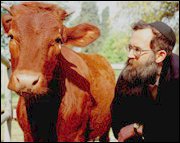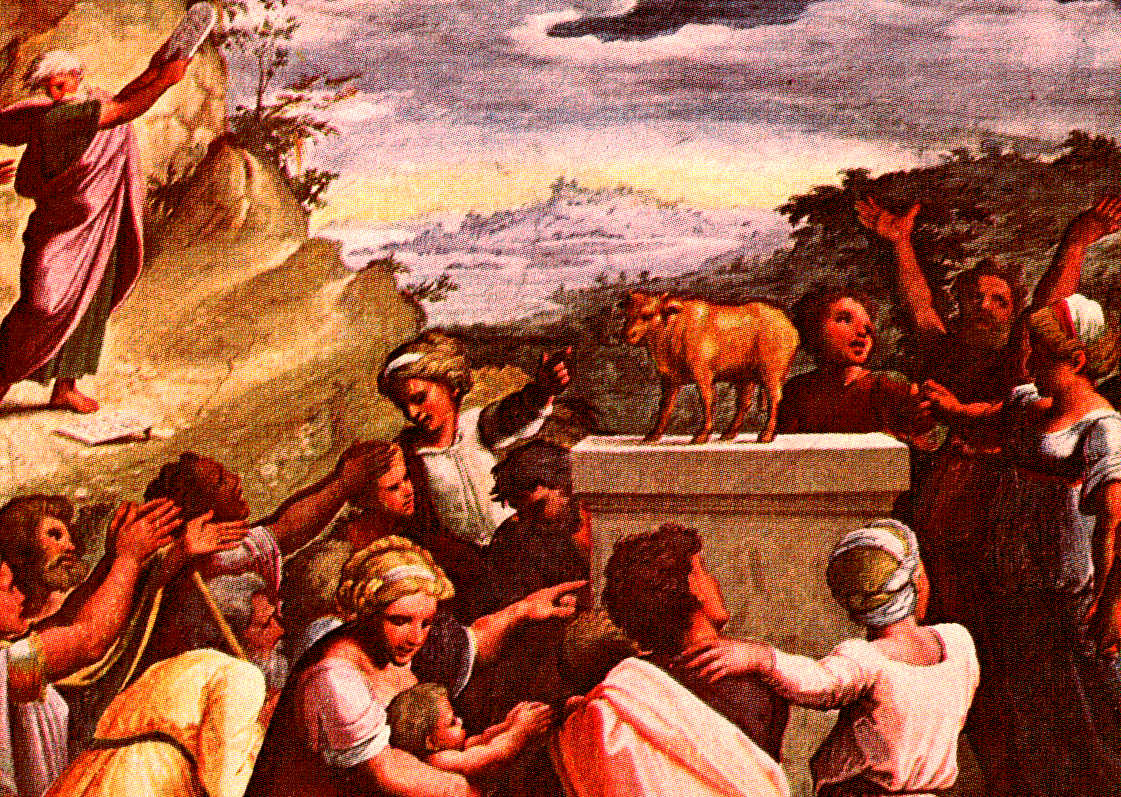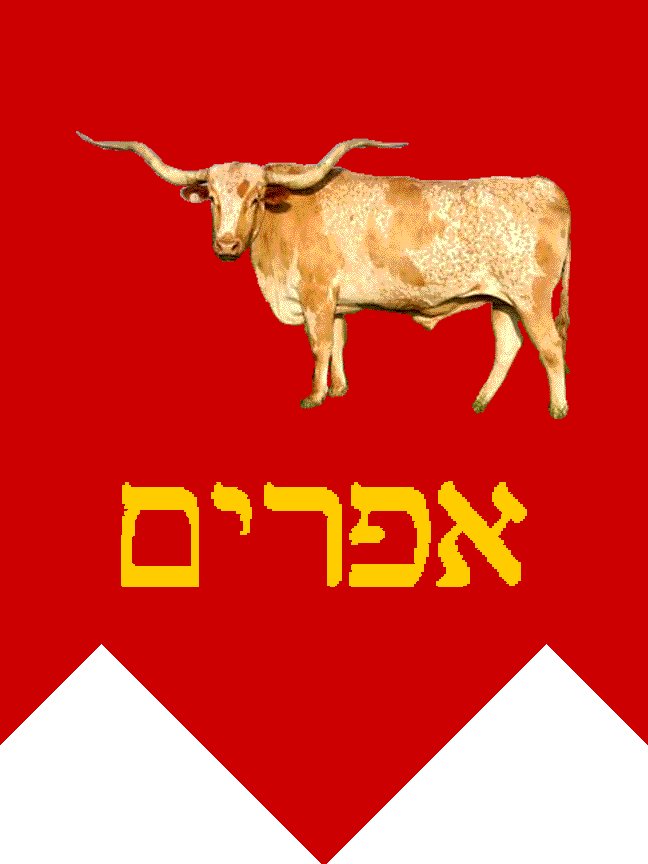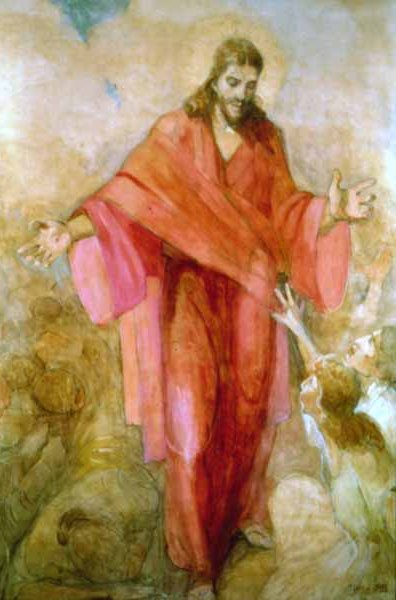126. Red Heifer ~ Golden Calf ~ Ensign of Ephraim ~ Christ Jesus
(An Offering Unto the Lord in Righteousness)
" . . . until the sons of Levi do offer again an offering unto
the Lord in righteousness." ~ D&C 13:1 (Also see:
3 Nephi 24:2-4, D&C 124:39, D&C 128:24, JS-History 1:69)
Putting to bed the dismissable variance of heifer and bullock. Ephraim's
ensign or banner is said to be a bullock, yet in Hosea 10:11 it is stated
that Ephraim is as an heifer, not a bullock. And many so associate
the 'red heifer' symbolism with Abraham's sacrifice of Isaac, there neither
Abraham or Isaac is female, yet the paralleled sacrifice of the 'red heifer' is
that of a female 'cow' that has not yet born a calf. Just where one may think
they need to distinguish the 'male' or 'female' sacrifice may be so comparable
as to assertain which do 'cowboys' herd? Herein a 'cow' is a 'cow', heifer or
bullock and the parallels of representation do not concern itself with is the
'red heifer Jesus Christ' male or female. The heifer represents Christ and the
ox or heifer are both 'cows' just as cowboys herd all cattle alike. Those who
concern themselves with such detail may ask themselves are they defending 'same
gender' in their wake? Here it is of no such issue. Bolvine is cattle just as
cows are cattle, irrespective of gender. And the red heifer, golden calf, ox of
Ephraim and Jesus Christ are all paralled and representative of the same in Christ
of Jesus' sacrifice in all their perspectives AND Christ is male irrespective of
heifer, bullock, calf or ox. Such distinguishments may well have been in part the
sin of Israel in the worship of the golden calf and rather so focusing on the 'cow'
rather than upon Jehovah, Jesus Christ, whom it was a type of, pointing to him and
none else.
Further, the representation of Jesus Christ as the 'red female heifer' is symbolic
and it has a very deep seeded gospel metaphoric meaning. As it is the 'female' that
births and gives life, we also are 'born of Christ' is purely the gospel sense. That
is we become his sons and daughter and are born again by a spiritual birth through
the power of the atonement of Christ as further represented by our outward ordinance
performance of baptism, that is being born of Christ. As all parable type metaphores,
if one attempt to apply too strict of an application of the details of the metaphore,
then the actual meaning becomes lost in the nitty-gritty insignificant detail. The
symbolism is what is important, not that Jesus become a female mother in this gospel
rebirth of baptism, but that metaphorically he does have that 'type' of power in
bringing forth children, sons and daughters of Christ unto the Father in a saving
gospel sense of 'rebirth' spiritually with the sins being washed away by the power
of his atonement.
The Red Heifer
I don't suspect that on that 15th day of May, 1829, at the age of
23 and some months, that Joseph Smith Jr. understood much about the
significance of 'The Red Heifer'. Some who choose to write about it today
begin with Moses setting forth the Lord's commandments concerning the
sacrifice of the red heifer in Numbers chapter 19. Others more appropriately
point back to the Abraham, the Abrahamic tradition and the Abrahamic Covenant and
those such sacrifices performed by Abraham particualarly including that of the
offered sacrifice of Isaac on Mount Moriah. In truth such sacrifice dates
back to the beginning days of Adam while in this lone and dreary earth.
 Now beginning with Moses, a number of scholars count that only 8 or 9 such red
heifer sacrifices have been so performed according to Numbers chapter 19
extending from Moses to the destruction of the Second Temple in 70 AD by the
Romans. And no such sacrifices have been performed since then and only that
final such sacrifice associated with the third temple and the coming Messiah,
is yet to be performed. According to such 'traditional' performances at
Jerusalem it interestingly was so conducted outside the city wall/gate at
a particular place on the Mount of Olives, which location has been tentatively
located by archaelologist Yonatan Adler. Just how that so correlates with the
garden of Gethsemane also on the Mount of Olives is of some speculative
interest to Christians who correctly identify the 'red heifer' with Jesus
Christ's atonement.
Now beginning with Moses, a number of scholars count that only 8 or 9 such red
heifer sacrifices have been so performed according to Numbers chapter 19
extending from Moses to the destruction of the Second Temple in 70 AD by the
Romans. And no such sacrifices have been performed since then and only that
final such sacrifice associated with the third temple and the coming Messiah,
is yet to be performed. According to such 'traditional' performances at
Jerusalem it interestingly was so conducted outside the city wall/gate at
a particular place on the Mount of Olives, which location has been tentatively
located by archaelologist Yonatan Adler. Just how that so correlates with the
garden of Gethsemane also on the Mount of Olives is of some speculative
interest to Christians who correctly identify the 'red heifer' with Jesus
Christ's atonement.
The supposed purpose the Jews present of the sacrifice of the 'red heifer' is
that of cleansing those who have come in contact with a dead corpse. With only
8 to 9 such sacrifices over the period of some 1500 years or so and then none
for the next 2000 years, hardly a sole has been so cleansed by the ashes of
that offering. Thus it must be considered that that death cleansing was not
merely that which was associated with a mortal relative, for who has not so
come in contact with such dead and if not cleansed to be lost? The more
universal death cleansing is that of the temporal and spiritual death brought
about by Adam, 'for as in Adam all die, even so in Christ, the red heifer',
is all to be made alive and cleansed from this fallen second estate of
mortal death both of the grave and from man's spiritual removal death from
the presence of God. And this is the why and the purpose for that great last
offering in conjunction with the Second Coming of the 'red heifter' to so
cleanse all in that 'single day' to be so redeemed, that the salvation of
the resurrection may be unto all and to all the opportunity unto exaltation
in the presence of God.
The Golden Calf
What was the logic behind the golden calf which Aaron did fashion for the
children of Israel? On the one hand it is give to be that calf, cow or heifer
of Hathor though it can be given that the Egyptians worshiped the image of
the 'cow' in a number of respects; ie: 'Apis', Greek for Hapi (Hape or Hap),
the sacred bull of Memphis, 'Mnevis', Greek name for the Egyptian sacred bull
Wer-mer worshipped at Heliopolis, and 'Buchis' a sacred bull worshiped at
Hermothis; as well as that 'cow' figure so associated with the Goddess
Hathor. In this respect it ought to be noted that in many respects the
religion of the Egyptians had at one time been so corrupted from a true
belief in Jehovah and the priesthood of God pretended to by Pharoah. Of
parallel interest it is Apis (Hapi) the sacred bull of Memphis which is
said was born of a virgin cow that had been impregnated by the god Ptah.
Thus the Egyptians has parallel representations of a 'holy cow' symbol as
did Israel in 'The Red Heifer'.
Of a particular not however it was Moses who pointed out that the
Egyptians would find an abomination in Israel's sacrifice to Jehovah and
that Israel therefore must need remove themself from Egypt to so perform
their sacrifice. This is considered to the actual sacrifice of the 'bull'
as Egypt held it sacred and Israel would offer it as a sacrifice (Exodus
8:25-27). It would seem that where Israel saw in the heifer a mean and
symbol to the end of the actual God Jehovah, the Egyptians had corrupted the
imagery to the extent of the actual worship of the bull, thus the means
of representation becoming the end in it self as the object of worship.
Here one ought to consider the perdicament that Aaron found himself in. Moses
had been gone for a goodly amount of time and the people came to Aaron, Moses'
spokesman with the demand that he produce for them a 'God Image'. In respect
to the sacrifices which Israel had so performed upon leaving Jerusalem, Aaron
knew of one image which was a type of the God Jehovah and the sacrifice he
would make. That image type of Jehovah was the 'heifer', that which the
Egyptians would have protested if they had observed Israel sacrificing such
to their God Jehovah. Aaron appears to have select just that image to point
 Israel to God in what he made. And though it was not Aaron's intent that the
children of Israel were to bow down and worship the calf itself, having been
so long among the Egyptians, that is just what the children of Israel did.
They seized upon the 'type' as the means representing what Christ's mission
would be and foresook the end being of God himself and worshipped instead
the reminder object, the bull itself rather than understanding what it did
represent. This would not be an unique occurance in Israel. In the days of
King Hezekiah, the Jews would once again begin to worship that which point
to Christ and King Hezekiah would have to destroy it, and that was the
image of the brazen serpent which was also but a representation of the
Messiah and not a god in and of it self (2 Kings 18:4). You see, the sin
was not in the 'Golden Calf', which Aaron likely meant but to point unto
Jehovah; but in the fact that the calf became an idol of worship in and of
itself. And the children of Israel began to worship the calf even as they
had observed the Egyptians so worship the calf in Egypt. Further in such
discussions which defend Aaron's integrity in designing and making a molten
calf and organizing a worship service thence with it being involved (Exodus 32), it is
said that Aaron's intent was not that the calf was God, but a symbol pointing
to God or even a representation of the 'throne' of God, that upon which God
would be set upon. This may add significance to the concept that it was upon
the back of Ephraim which the Messiah would be raised up upon, inferring
further that Messiah would be the heir of the firstborn of Israel, that is
Ephraim and/or Joseph; the 'calf' or 'ox' being the symbol of the tribe of
Ephraim. And it might be considered that other than Joshua who was with Moses
upon the mount, it was the leaders of the tribe of Ephraim who persuaded
Aaron to so craft such a symbolic representation as the calf in such
represnting God to come of the tribe of Ephraim.
Israel to God in what he made. And though it was not Aaron's intent that the
children of Israel were to bow down and worship the calf itself, having been
so long among the Egyptians, that is just what the children of Israel did.
They seized upon the 'type' as the means representing what Christ's mission
would be and foresook the end being of God himself and worshipped instead
the reminder object, the bull itself rather than understanding what it did
represent. This would not be an unique occurance in Israel. In the days of
King Hezekiah, the Jews would once again begin to worship that which point
to Christ and King Hezekiah would have to destroy it, and that was the
image of the brazen serpent which was also but a representation of the
Messiah and not a god in and of it self (2 Kings 18:4). You see, the sin
was not in the 'Golden Calf', which Aaron likely meant but to point unto
Jehovah; but in the fact that the calf became an idol of worship in and of
itself. And the children of Israel began to worship the calf even as they
had observed the Egyptians so worship the calf in Egypt. Further in such
discussions which defend Aaron's integrity in designing and making a molten
calf and organizing a worship service thence with it being involved (Exodus 32), it is
said that Aaron's intent was not that the calf was God, but a symbol pointing
to God or even a representation of the 'throne' of God, that upon which God
would be set upon. This may add significance to the concept that it was upon
the back of Ephraim which the Messiah would be raised up upon, inferring
further that Messiah would be the heir of the firstborn of Israel, that is
Ephraim and/or Joseph; the 'calf' or 'ox' being the symbol of the tribe of
Ephraim. And it might be considered that other than Joshua who was with Moses
upon the mount, it was the leaders of the tribe of Ephraim who persuaded
Aaron to so craft such a symbolic representation as the calf in such
represnting God to come of the tribe of Ephraim.
Now Aaron would not be the only one in Israel to so form a 'golden heifer'
for Israel to look unto as an 'image of God'. The king so selected by a
prophet of God unto Israel, Jeroboam, would likewise so institue such images
in the Kingdom of Israel and perhaps for not so pure of an intent as was
Aaron's. Yet acheaologies have found in the land of Samaria such inscriptions
as referring to the 'calf of Jehovah', and it would seem that they had
retained in their 'calf worship' the concept that the 'calf was of Jehovah'.
(Eislen, Lewis and Downey have mentioned in passing a 'potsherd' found in
Samaria inscribed 'Egeliah' which means in Hebrew "bull-calf of Yah" ~ "heifer
of Jehovah'. The Baalistic worship of the actual 'cow' is the sin and
corruption taken from such as the sacrifice of the 'bull heifer' unto God
Jehovah as a representation pointing unto Christ.
In respect to the 'molten calf' which Aaron did fashion as an image type of
Christ, Aaron did build an altar for the sacrifice of oxen, the 'peace
offering' (Exodus 24:5-8) in remembrance of the God Jehovah. But the people
were in their offerings but offerings unto the golden calf itself and they
began to 'play' before it even as the Egyptians before their heifer god in
Egypt (Exodus 32:4-10).
Ironically, whereas the 'golden calf' of Aaron efforts failed in pointing
Isreal to their God as the image of the 'heifer of atoning sacrifice' upon
the mount of olives, it would be Moses in Numbers 21 who would there raise up
a 'brasen serpent' symbolizing the lifting up of the Messiah upon the cross.
Ensign of Ephraim
At this point consideration ought to be given to the fact that the 'Ensign',
that is the 'banner' raised of the tribe of Ephraim, is in fact the bull
 heifer. In Israel, as organized by Moses, each 'man of the children of Israel
was to pitch by his own standard, with the ensign of his father's
house (Numbers 2:2). And the engsin of Ephraim, that tribal father
in Israel, was bullock 'cow' or ox of the sacrifice of the peace offering,
(Exodus 24:5) and more specifically that of the 'red heifer' (Numbers 19).
In these latter-days it is Ephraim's covenant responsibility to carry the
Ensign before the world, to gather Israel and to fulfill the covenant of
Abraham unto the blessing of all the nations of the earth. What is that
ensign, to what or whom is Israel to be gather and what is it that will
bless the nations of the earth? Is it not Christ and his restored gospel
which will so bless the nations of the world and to which Israel is to be
gathered? The ensign of Ephraim is the ox of the peace offering even extending
itself unto that representation of Jesus Christ which will redeem the whole
earth and provide the way that man may be saved in him. In this Christ is the
sacrifical ox of Ephraim and only in and through him may man be redeemed and
gain exaltation. And of that ensign Isaiah chapter 11 does state that it
'shall stand for an ensign of the people and that the Gentiles will seek it
as well as all the earth to come unto his rest which shall be glorious (see
Isaiah 11:10-16).
heifer. In Israel, as organized by Moses, each 'man of the children of Israel
was to pitch by his own standard, with the ensign of his father's
house (Numbers 2:2). And the engsin of Ephraim, that tribal father
in Israel, was bullock 'cow' or ox of the sacrifice of the peace offering,
(Exodus 24:5) and more specifically that of the 'red heifer' (Numbers 19).
In these latter-days it is Ephraim's covenant responsibility to carry the
Ensign before the world, to gather Israel and to fulfill the covenant of
Abraham unto the blessing of all the nations of the earth. What is that
ensign, to what or whom is Israel to be gather and what is it that will
bless the nations of the earth? Is it not Christ and his restored gospel
which will so bless the nations of the world and to which Israel is to be
gathered? The ensign of Ephraim is the ox of the peace offering even extending
itself unto that representation of Jesus Christ which will redeem the whole
earth and provide the way that man may be saved in him. In this Christ is the
sacrifical ox of Ephraim and only in and through him may man be redeemed and
gain exaltation. And of that ensign Isaiah chapter 11 does state that it
'shall stand for an ensign of the people and that the Gentiles will seek it
as well as all the earth to come unto his rest which shall be glorious (see
Isaiah 11:10-16).
And concering that blessing unto Joseph through Ephraim's 'fruit of his
loins' it states in the JST:
"For thou hast prevailed, and thy father's house hath bowed
down unto thee, even as it was shown unto thee, before thou was sold into
Egypt by the hands of thy brether; wherefore thy brethern shall bown down unto
thee, from generation to generation, unto the fruit
of thy loins for ever; For thou shalt be a light unto my
people, to deliver them in the days of their captivity, from bondage;
and to bring salvation unto them, when they are altogether bowed down under
sin." ~ JST Genesis 48:10-11
And now again, it is unto the latter-day gathering that man will be
redeemed from being so bound by sin to being altogether bowed down under it.
And it is that fruit of Joseph's loins through his son Ephraim, even Jesus
Christ whom Isreal will bow down to for ever. And that salvation is in Christ,
the very image of the ensign of Ephraim, the ox of the peace offering, unto
all the world raised in
fulfillment of the blessing of the nations of the earth according to the
covenant of Abraham, and also of those promises that were made unto all the
fathers including
Noah, Enoch and even Adam from the beginning. Yes every knee will bow and
every tongue confess that Jesus is the Christ and worship him for ever more,
Amen. (see: Romans 14:10-11, Philippians 2:10-11, Mosiah 16:1, Mosiah 27:31,
D&C 76:110, and D&C 88:104)
Christ Jesus
That which logically ties and makes sense of it all, is that Christ's
atoning sacrifice was represented by the 'red heifer', it was unto Christ
 who Aaron intended that Israel should see in his golden calf, and it was
but the favored coming of the Messiah ben Ephraim that the heifer ensign
of Ephraim did represent and point to. That is the heifer in all things did
so correctly in truth represent Jesus Christ. Yet the idol worship of the
heifer in and of itself and not as type image pointing to Christ, was the
sin which Israel would founder in. And herein ought to be a lesson unto the
latter-day saints. "The Ensign of Ephraim is Jesus Christ."
who Aaron intended that Israel should see in his golden calf, and it was
but the favored coming of the Messiah ben Ephraim that the heifer ensign
of Ephraim did represent and point to. That is the heifer in all things did
so correctly in truth represent Jesus Christ. Yet the idol worship of the
heifer in and of itself and not as type image pointing to Christ, was the
sin which Israel would founder in. And herein ought to be a lesson unto the
latter-day saints. "The Ensign of Ephraim is Jesus Christ."
The four creatures, man, eagle, lion and ox; represent four aspects of Christ
Jesus. The aspect of the lion of Judah is well known and accepted, for he is
Messiah ben David. The aspect of the ox of Ephraim is not so well understood
but rest assured in this aspect Christ is Messiah ben Ephraim. Perhaps as
man, Christ stands as that Son of Man, even that Man of Holiness, God the
Father of Spirits. Thus in these three aspects Christ is of the blood linage
of Judah through Mary, of the divine linage of God the Father as the first
begotten in the spirit and the only begotten in the flesh, and of the linage
of the covenant of Ephraim by the law of God as Obed was the legal and
rightful heir of the covenant of the house of Ephraim by being raised up to
the dead and of the house and lineage of Mahlon, Elimelech, even the son of
Naomi, those Ephrathites of Bethlem. As to the aspect of the eagle, that is
not a topic of this text, nor understood well by it. But one might look unto
that 'born again' baptism, for even of Christ was it so in order to 'fulfill
all righteousness'. And that birth of baptism was not only of water but of
the spirit, that eagle of the spirit unto the sanctification of man unto
exaltation of becoming even as God is, which is life eternal being even beyond
immortality. It is the 'eagle' which is without beginning or end, that eternal
thing which must come even before one's birth of the other Fathers and
continues on beyond into all eternity to come.